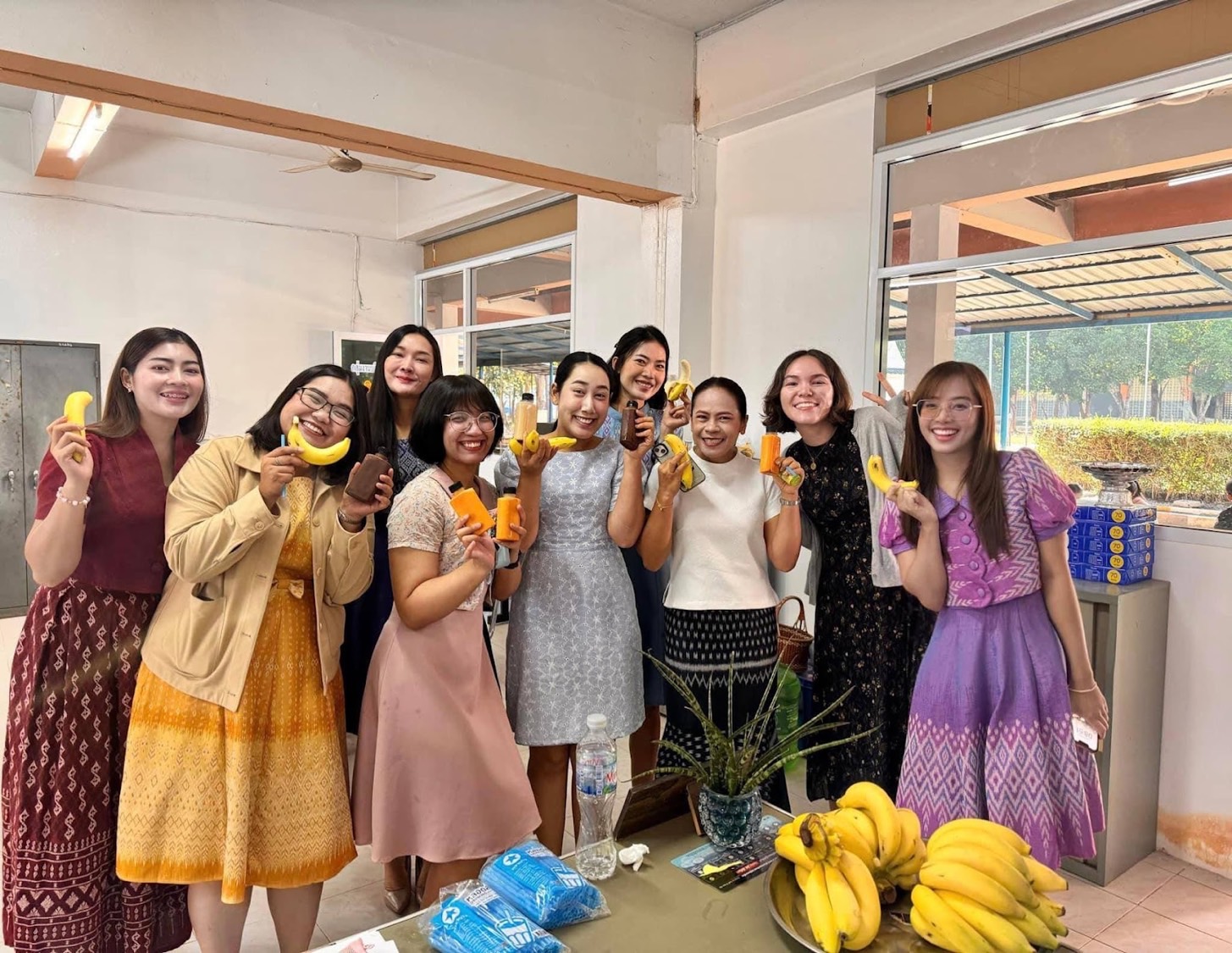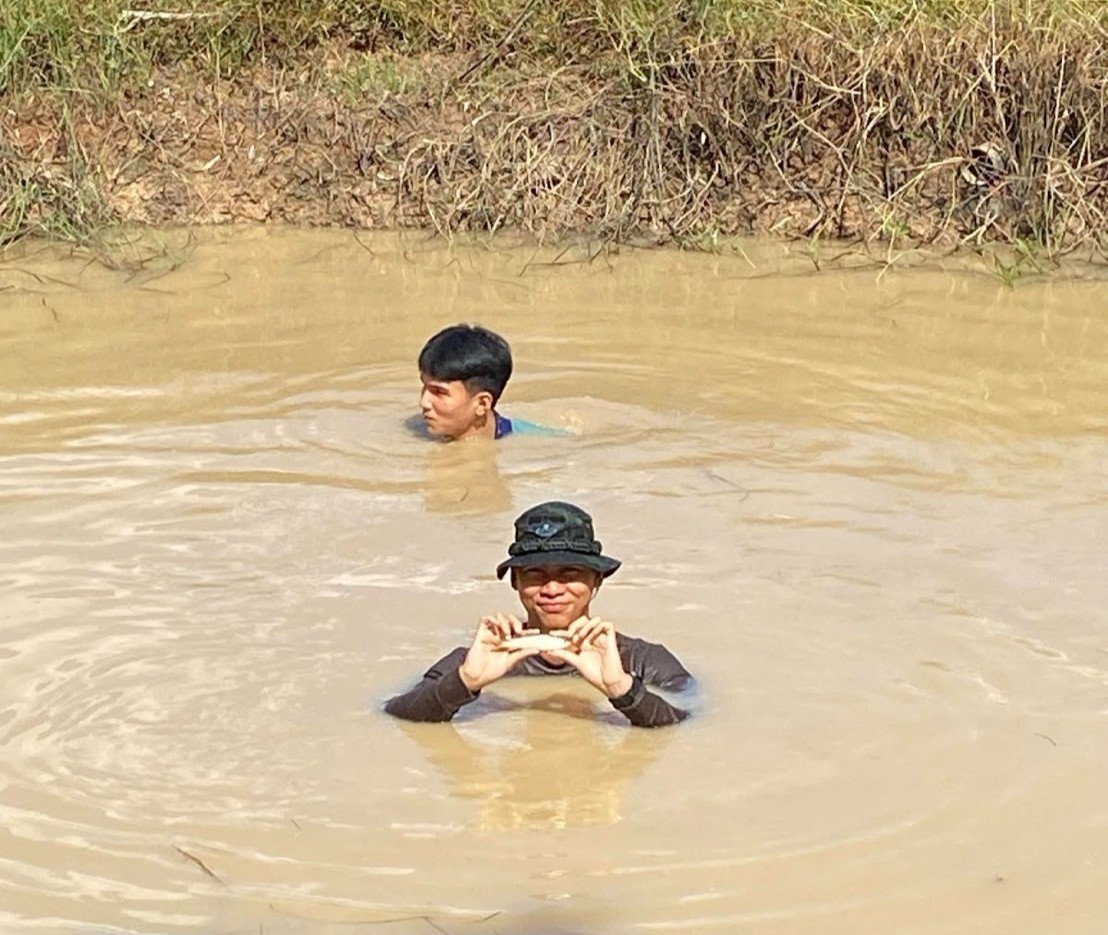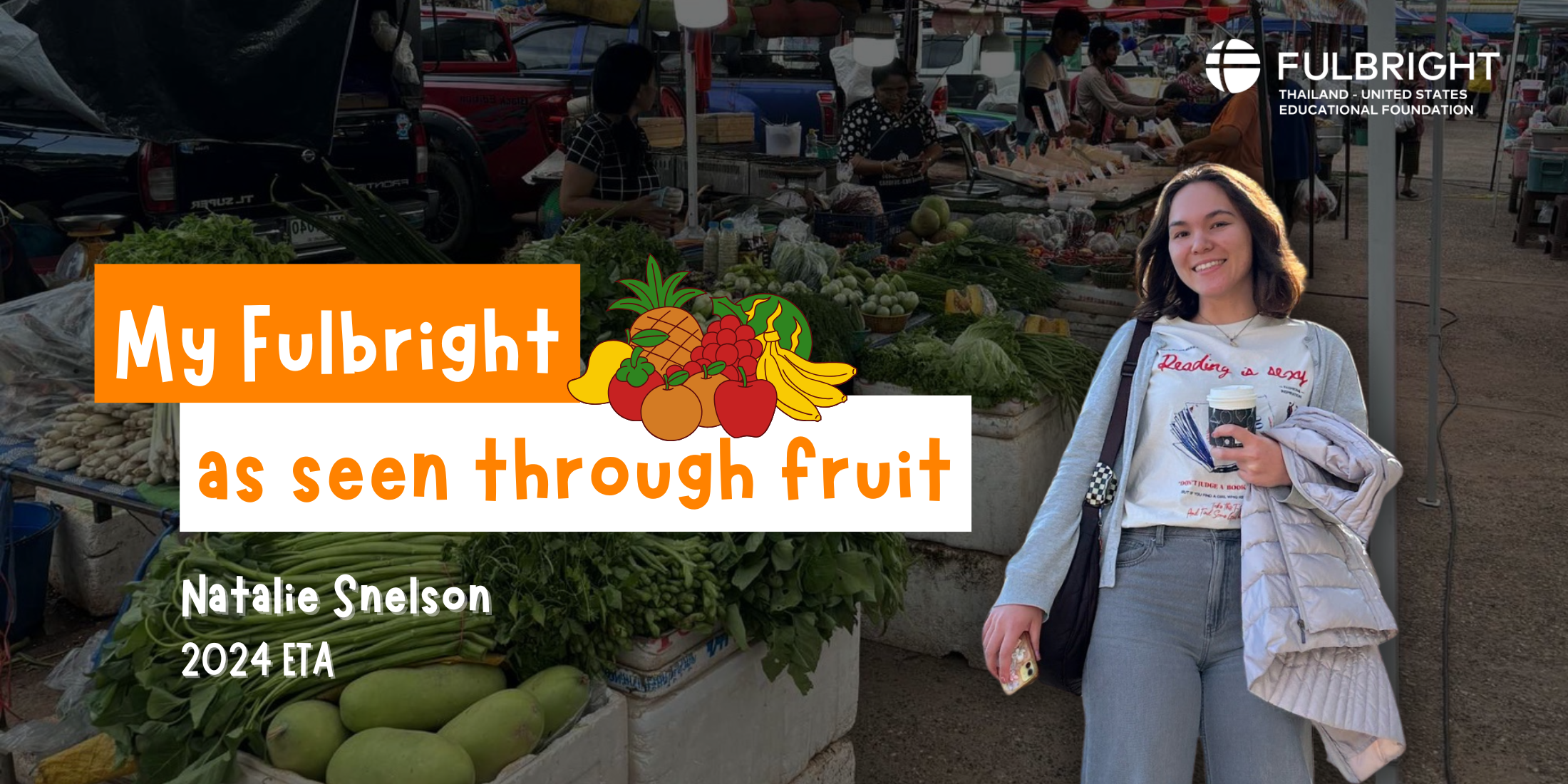My Fulbright, as seen through fruit
Baan Nam Suay, my host placement for my ETA year in Thailand, is a village located on the border of Udon Thani and Nong Khai provinces. The Nam Suay Wittaya school is a small but mighty school, home to the warmest of teachers and students. And what better community to learn about Thailand’s fruit scene than Nam Suay? Nam Suay’s culture of family style eating prevails, ingrained in my daily life at the dining table at school. Following each meal we share a fruit. Watermelon. Rambutan. Dragonfruit. Here is where I’ve tasted my first pomelo, spilled my first fresh coconut water, and peeled my first Longan. The cycle of fruits I encountered at this dining table, and the community that grew around it, inspired me to pen these stories. As an ode to the Nam Suay community, the following stories share memories of my encounters with Thai fruit.
My first month, my first glûay
The first few words I learned in-province, alongside “sit” (naang) and “go” (bpai), is “banana” (glûay). This already familiar fruit bore many surprises. My first meal at the Nam Suay dining table was Naem Nueang, a Vietnamese-turned-Thai food and a staple in Nong Khai, consisting of meatballs, fruits, and vegetables wrapped in a spring roll sheet dipped in sauce. I remember my confusion at the sight of an unripe banana on the plate. Who knew you could eat unripe bananas! The texture, starchy and firm, paired surprisingly well with the meatball and peanut sauce. Naem Nueang quickly rose to be one of my favorite Thai foods.

A few weeks later, bananas appeared on the table again, bushel after bushel stacked high. I don’t remember why they were there exactly, and why so many, but I do remember being startled by their size: miniature compared to those from home. So began P’Pingpong’s impromptu banana lesson; she taught me the basics of Thai bananas, namely their different tastes, uses, and names. Glûay Nam Waa, or small Thai banana; a versatile fruit that can be roasted, fried, or boiled with coconut milk. Glûay Hom, described to me as the “western banana;” bananas I would eat with yogurt back home in the U.S. As I savored this Glûay Nam Waa with P’Pingpong and the other teachers, I reveled in these new memories at Nam Suay that blossomed first through Thai bananas.
Cooking my first Somtam, or Papaya Salad
A month passed since I'd landed in Nong Khai, and we visited a nearby farm for the annual rice harvesting field trip. I rolled up my sleeves, held a sickle in hand, and zipped up a UV protection jacket I borrowed from P’Plai up to my nose. I’d never felt as much appreciation for the rice I eat everyday as this very moment.

After an hour under the beating sun somewhat successfully harvesting some rice (my students are much better at handling the sickle than I), I walked over to some students in the shade who called out to me.
“Teacher papaya pok pok!!! PAPAYA POK POK!”
Following this strange calling I joined them on their mat, laden with bowls of chilis and limes, containers of fish sauce and shrimp paste. Only then did I put it all together - they were making somtam, or papaya salad. “Pok pok” the sound of pounding the ingredients together. Gripping the peeled papaya in one hand and the knife in the other, I whacked the papaya with the knife until I made several parallel cuts, and shaved down the papaya to create shreds. The shreds fell into the krog—a Thai-style mortar—to pound and melange the ingredients together.
Soon after I finished my papaya cutting, I was greeted yet again by a student calling me. TEACHER! She rushed over and grabbed my arm guiding me toward the pond, where students appeared to be flailing in the water. Turns out, they were fishing for an addition to our lunch. I couldn’t help but smile when my M6 student proudly held up a small fish like a hard-won trophy.

At Nam Suay, especially in those early weeks, my tongue had failed me in speaking Thai; connecting with students and teachers posed a never-ending challenge. But as I sat among students with the chorus of pok poks urging me on, or felt the strong grip on my arm leading me to yet another sight to see, I found solace in this newfound communication, one transcending language. Here, my flawed Thai is received with openness, body language always flowing and free. At Nam Suay, I learned the many ways of communication.
Feeling a local vendor’s love - Mangosteen
The Nam Suay Wittaya School embraces conscious eco-friendly efforts. The school houses a garden for students to learn farming practices, and composting areas dot the entire campus. It’s thus no surprise that I indulge in farm-to-table eating here everyday. Many of my school meals source ingredients directly from nearby farms. The market right by my apartment sells the freshest produce: mangoes plucked from neighboring trees and eggs from my neighbor’s chickens. It’s been such a joy to notice the seasons change through the fruit that line the vendor’s stalls.

My fruit vendor expects me every Monday. She waves me over, calling me “Ajan Natalie,” or teacher Natalie. On this day, I meant to buy a few hefty dragonfruits I enjoyed the previous week, but stopped to find a new fruit at the table. Mangkhud, she called it. One of my M6 student’s nickname is Mangkhud — his nickname’s meaning a mystery until that very moment. She stuck a few in my hand, showing me how I could jab my fingers in its flesh to reveal the white pearly fruits in the middle. Mangosteen became one of my favorite fruits. And my fruit vendor knew it too, because she always sneaks a few mangosteens in my bag of whatever fruit I bought that day. Despite the bag’s weight going well over the usual 1kg, my fruit vendor never seems to mind.
Mayongchit - a gift from a neighbor in Chonburi
Steering away from Nong Khai a bit, this story takes place in Chonburi, a province just an hour drive away from Bangkok. For internship month, I lived in Bang Saen, a beach and college town in Chonburi, to work for Burapha University’s Master of Education Program in Teaching English as a Global Language. During the month, I led conversational English language workshops for the administrators and faculty members working in the Graduate program.

I lived in faculty housing, right on the border of the university. With the large campus and the crowds of students around, it felt worlds different from what I’d become adjusted to in rural Nong Khai. At school, I’d pass my students every moment of the day, my “hello good morning how are you’s” ready for anyone I encountered. At Burapha, the only person I’d say hello to on my way to the office was the security guard. It was thus a welcome relief to know that one of my coworkers, P’Or, turned out to be one of my neighbors. Having a familiar face around was a small comfort, especially after getting used to the cacophony of hellos back in Nam Suay.
One evening after work, P’Or knocked on my door. She cradled a small bowl filled with a vibrant yellow fruit, cut concisely into bite-size pieces. The fruit presented a curious taste, reminiscent of both a plum and a persimmon. She had introduced me to Mayongchit, also known as plum mango or Marian plum, a fruit only available from February to April in Thailand. A few days later, my supervisor P’Beau would also treat me to some Mayongchit for a much appreciated midday treat.

Though I only lived in Bang Saen for a month, small gestures such as these made me feel quickly at home. It reminded me of my own mom, cutting fruits and steeping tea as our after dinner treat. Despite being hundreds of miles away from home, I felt the same love of sharing fruit with others. I felt the endless ways we show care to one another - through words, through actions, and of course, through fruit.
Farang, or better yet, Baksida
Nam Suay Wittaya School is located on Thanon Mitrapap, the main highway that connects the Isaan region to Bangkok and central Thailand. Entering the school to escape the bustling of cars and motorcycles, you are met with an almost surprising serenity. As another ETA, Zab, described it, “you go straight from highway to forest.”
Within the calm that houses Nam Suay rings the lively, colorful voices of the Isaan dialect. Nam Suay feels like the heart of Isaan, enveloped in the warmth of its people and the pride of its language. The students would rather teach me Isaan than Thai, laughing along as I pronounce and mispronounce the language at every attempt. The local market has also become my classroom for Thai and Isaan alike. On one occasion, I picked up some guavas to share with teachers. When chatting with my usual fruit vendor, she taught me the word for guava: baksida.
The next day, I walked into school with a bag of guavas, and curious students gathered to ask what I held in hand. Baksida, I told them, eager to showcase what I thought was a new Thai vocabulary word. They roared in laughter. I learned then that baksida isn't Thai at all—it's Isaan. The Thai word for guava is farang. My cheeks burned red, embarrassed by my mistake. Learning Thai and Isaan is no easy feat. Some days I feel like I’m making progress, animated by small victories. Some days I surprise myself with how much more progress I have yet to make. But coupled with language learning is vulnerability. Not a day goes by without feeling embarrassed; I can never evade misplacing a tone that changes meaning, or using the wrong word entirely. Yet I won’t spare any embarrassment on my behalf, if it means bringing laughter to my students' faces each day.
The Mighty Mango, amongst others
If there’s anything that hasn’t changed all year in our office, it’s the mangoes. Throughout my Fulbright year, mangoes have made an emergence time and time again at our lunch table. Raw mango eaten with salt and chili, ripe mango cut for everyone that stops by to enjoy. I still remember the shock I felt when seeing the plates on plates of mangoes on the table. “Maa gin ma-muang gòn,” P’Biew, my host teacher, says. “Come eat some mangoes.”

There is always fruit, among other snacks, on our table. At first, I thought that Thai people love eating (and granted, I’ve found out that this is very much still true. I now understand that it isn’t only the act of eating that is appreciated, but the act of sharing. The act of sharing fruit, and food, serves as just one of many acts of kindness, embedded in Thai culture. Whether it be one of my teachers, P’Nut, putting a bushel of bananas in my hand to eat at home (from my mom’s garden! he always boasts proudly), or P’Biew leaving a bag of mangoes on my desk, I feel love and care here in ways I’ve never felt before.

Life at Nam Suay is peaceful, intimate, and warm; the community as sweet as the banana, mayongchit, or mangosteen I eat. Each piece of fruit I come across carries more than a flavor, but a memory and an indescribable warmth. As I make my return back to the United States, I am sure to carry forward the kindness I’ve felt here, even long after I’ve forgotten the exact taste of a perfectly ripe mango. Here at Nam Suay, I feel an enduring love, expressed many times through fruit.

